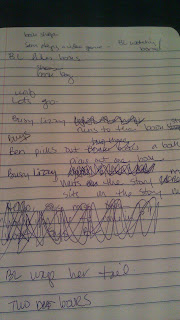I'm currently sharing the key learning points discussed in my young writers' workshop entitled, "Gotcha! How to Find and Capture Great Writing Ideas."
I begin this section of the workshop by asking students to share why they think the above statement is true. We talk about how reading exercises the muscles in the brain and how a stronger brain can write stronger stories. We talk about how reading other authors' books can help writers come up with their own ideas. We talk about how re-reading your own notebook or journal can remind you of writing ideas you forgot you remembered! We also talk about how reading a good book can be relaxing, which might be just what your brain needs to help you come up with good ideas.
 This is when I bring out my beloved trophy. I let students know that this is the only trophy I've ever earned. I tell them that I earned it in the 5th grade, and I invite students to make guesses about how I earned it. (I'm always touched that some kids guess it's an award for my current books!).
This is when I bring out my beloved trophy. I let students know that this is the only trophy I've ever earned. I tell them that I earned it in the 5th grade, and I invite students to make guesses about how I earned it. (I'm always touched that some kids guess it's an award for my current books!).
I eventually tell students that this trophy is the coveted Pleasure Reading Award that I earned in Mr. Snook's 5th grade class. Mr. Snook ran a pleasure reading contest each year. The student who read the most books during the school year won the award. I explain that I started at one end of my school library and snaked my way around the room. I do not remember how many books I read or how far I got into the library's shelves, but I do know that I read the most books that year. I also know that all of that reading contributed to my being an effective writer today.
And this brings us to the last learning point, Big Idea #5: WRITE and WRITE and WRITE some more, which I'll discuss in my next post.
 This is when I bring out my beloved trophy. I let students know that this is the only trophy I've ever earned. I tell them that I earned it in the 5th grade, and I invite students to make guesses about how I earned it. (I'm always touched that some kids guess it's an award for my current books!).
This is when I bring out my beloved trophy. I let students know that this is the only trophy I've ever earned. I tell them that I earned it in the 5th grade, and I invite students to make guesses about how I earned it. (I'm always touched that some kids guess it's an award for my current books!). I eventually tell students that this trophy is the coveted Pleasure Reading Award that I earned in Mr. Snook's 5th grade class. Mr. Snook ran a pleasure reading contest each year. The student who read the most books during the school year won the award. I explain that I started at one end of my school library and snaked my way around the room. I do not remember how many books I read or how far I got into the library's shelves, but I do know that I read the most books that year. I also know that all of that reading contributed to my being an effective writer today.
And this brings us to the last learning point, Big Idea #5: WRITE and WRITE and WRITE some more, which I'll discuss in my next post.









